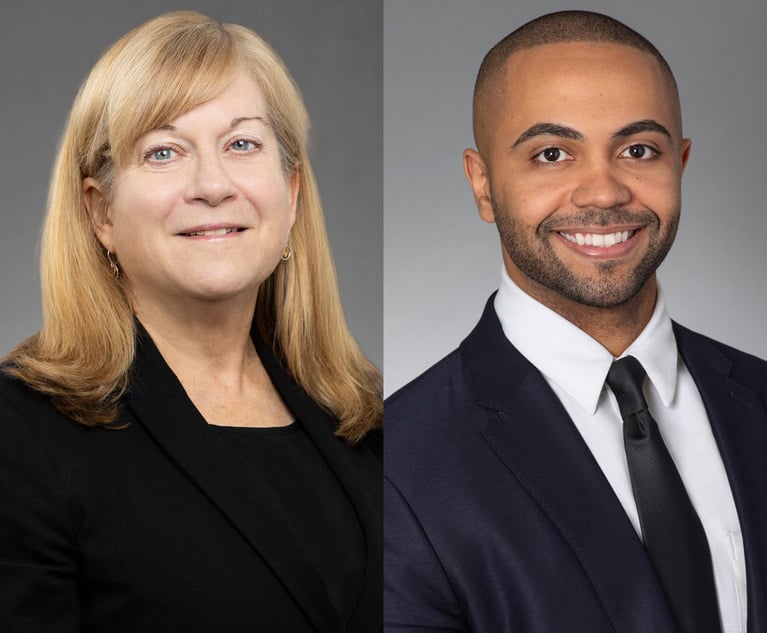Health, Safety Inspection Failures on Cruise Ships and What It Means for Consumers, Industry
The cruise industry is getting a lot of media attention this year, but not for their exciting new ships which feature onboard hair-raising water slides, go-kart tracks and smokehouse BBQ joints, but because of the increased number of failed ship inspections performed pursuant to by the Centers for Disease Control and Prevention's Vessel Sanitation Program (CDC-VSP).
March 30, 2018 at 12:28 PM
4 minute read

The cruise industry is getting a lot of media attention this year, but not for their exciting new ships which feature onboard hair-raising water slides, go-kart tracks and smokehouse BBQ joints, but because of the increased number of failed ship inspections performed pursuant to by the Centers for Disease Control and Prevention's Vessel Sanitation Program (CDC-VSP). In fact, during 2017 more cruise ships failed their inspection than any other year since the inception of the CDC's protocol.
Carnival Cruise Line, the world's largest cruise line—is based in Miami and had five ships fail in 2017 and several so far this year—and they are not alone. Norwegian, Royal Caribbean and others are also failing. But Carnival's problems seem the most glaring and potentially dangerous—so for this year the Liberty scored 80 on Jan. 4, the Vista scored 88 on Jan. 27 and the Ecstasy scored 87 on Feb. 11.
The CDC inspections are performed at least twice a year, randomly on ships that dock at U.S. ports and focuses on a few key safety concerns—but not every aspect of a ship's operations. The inspections are actually paid for by each cruise line depending on the size of a given ship.
The ships are then scored on a 100-point scale. A score of 85 or below is considered failing. However, even ships that score 100 can have half dozen violations or more. Inspectors will examine the ship's medical center and review medical logs to make sure that there is accurate documentation of gastrointestinal illness surveillance to help mitigate the spread of the Norovirus and other GI illnesses. Inspectors will check a ship's procedures for maintaining and distributing potable water, swimming pool and jacuzzi filtration and disinfection systems, food storage, service and cleaning areas, kids' clubs and nurseries, hotel accommodations as well as the ship's heating, ventilation and air conditioning systems. They do not however, check safety measures like whether or not the decks are too slippery when wet or if there is adequate lighting on exterior staircases.
The question many in the cruise industry are asking, as well as consumers trying to find the best and safest way to spend their hard-earned vacation dollars are: why is this happening and how can it be avoided?
As a lawyer who has investigated thousands of cruise ship related accidents and injury claims, I believe one of the reasons that the cruise lines are experiencing an increase in the number of reported health inspection failures is due to the increased number of ships at sea coupled with a lack of accountability or consequence for failing a CDC inspection. In the worst case scenario the VSP can issue a “no-sail” order, which means that the ship possesses an “imminent public health risk” and cannot set sail until the violations are corrected. I am personally unaware of any major cruise line ever being given a “no-sail” order regardless of how poorly they performed on a given inspection.
Until such time as there is a legislative initiative to assess either civil or criminal penalties for failing a CDC inspection—consumers are best advised to spend some time on the CDC's website to see just how well their intended ship performed during its inspection before booking their next cruise.
Spencer Aronfeld is the founder of Aronfeld Trial Lawyers in Miami. He is a board-certified civil trial lawyer and has successfully represented injured people and their families in accident cases against cruise lines.
This content has been archived. It is available through our partners, LexisNexis® and Bloomberg Law.
To view this content, please continue to their sites.
Not a Lexis Subscriber?
Subscribe Now
Not a Bloomberg Law Subscriber?
Subscribe Now
NOT FOR REPRINT
© 2024 ALM Global, LLC, All Rights Reserved. Request academic re-use from www.copyright.com. All other uses, submit a request to [email protected]. For more information visit Asset & Logo Licensing.
You Might Like
View All

As a New Year Dawns, the Value of Florida’s Revised Mediation Laws Comes Into Greater Focus
4 minute read
Data Breaches, Increased Regulatory Risk and Florida’s New Digital Bill of Rights
7 minute read
Navigating Florida's Products Liability Law: Defective Products, Warnings and the Pursuit of Justice
6 minute readTrending Stories
- 1'Largest Retail Data Breach in History'? Hot Topic and Affiliated Brands Sued for Alleged Failure to Prevent Data Breach Linked to Snowflake Software
- 2Former President of New York State Bar, and the New York Bar Foundation, Dies As He Entered 70th Year as Attorney
- 3Legal Advocates in Uproar Upon Release of Footage Showing CO's Beat Black Inmate Before His Death
- 4Longtime Baker & Hostetler Partner, Former White House Counsel David Rivkin Dies at 68
- 5Court System Seeks Public Comment on E-Filing for Annual Report
Who Got The Work
Michael G. Bongiorno, Andrew Scott Dulberg and Elizabeth E. Driscoll from Wilmer Cutler Pickering Hale and Dorr have stepped in to represent Symbotic Inc., an A.I.-enabled technology platform that focuses on increasing supply chain efficiency, and other defendants in a pending shareholder derivative lawsuit. The case, filed Oct. 2 in Massachusetts District Court by the Brown Law Firm on behalf of Stephen Austen, accuses certain officers and directors of misleading investors in regard to Symbotic's potential for margin growth by failing to disclose that the company was not equipped to timely deploy its systems or manage expenses through project delays. The case, assigned to U.S. District Judge Nathaniel M. Gorton, is 1:24-cv-12522, Austen v. Cohen et al.
Who Got The Work
Edmund Polubinski and Marie Killmond of Davis Polk & Wardwell have entered appearances for data platform software development company MongoDB and other defendants in a pending shareholder derivative lawsuit. The action, filed Oct. 7 in New York Southern District Court by the Brown Law Firm, accuses the company's directors and/or officers of falsely expressing confidence in the company’s restructuring of its sales incentive plan and downplaying the severity of decreases in its upfront commitments. The case is 1:24-cv-07594, Roy v. Ittycheria et al.
Who Got The Work
Amy O. Bruchs and Kurt F. Ellison of Michael Best & Friedrich have entered appearances for Epic Systems Corp. in a pending employment discrimination lawsuit. The suit was filed Sept. 7 in Wisconsin Western District Court by Levine Eisberner LLC and Siri & Glimstad on behalf of a project manager who claims that he was wrongfully terminated after applying for a religious exemption to the defendant's COVID-19 vaccine mandate. The case, assigned to U.S. Magistrate Judge Anita Marie Boor, is 3:24-cv-00630, Secker, Nathan v. Epic Systems Corporation.
Who Got The Work
David X. Sullivan, Thomas J. Finn and Gregory A. Hall from McCarter & English have entered appearances for Sunrun Installation Services in a pending civil rights lawsuit. The complaint was filed Sept. 4 in Connecticut District Court by attorney Robert M. Berke on behalf of former employee George Edward Steins, who was arrested and charged with employing an unregistered home improvement salesperson. The complaint alleges that had Sunrun informed the Connecticut Department of Consumer Protection that the plaintiff's employment had ended in 2017 and that he no longer held Sunrun's home improvement contractor license, he would not have been hit with charges, which were dismissed in May 2024. The case, assigned to U.S. District Judge Jeffrey A. Meyer, is 3:24-cv-01423, Steins v. Sunrun, Inc. et al.
Who Got The Work
Greenberg Traurig shareholder Joshua L. Raskin has entered an appearance for boohoo.com UK Ltd. in a pending patent infringement lawsuit. The suit, filed Sept. 3 in Texas Eastern District Court by Rozier Hardt McDonough on behalf of Alto Dynamics, asserts five patents related to an online shopping platform. The case, assigned to U.S. District Judge Rodney Gilstrap, is 2:24-cv-00719, Alto Dynamics, LLC v. boohoo.com UK Limited.
Featured Firms
Law Offices of Gary Martin Hays & Associates, P.C.
(470) 294-1674
Law Offices of Mark E. Salomone
(857) 444-6468
Smith & Hassler
(713) 739-1250






